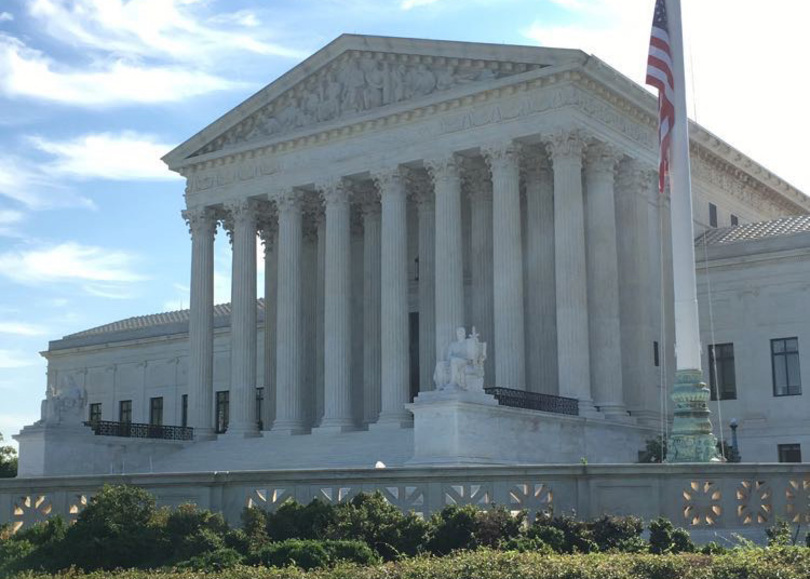SCOTUS outlaws affirmative action admissions policies in joint decision for 2 cases

Dominic Chiappone | Asst. News Editor
The Supreme Court ruled to overturn affirmative action, a policy that allows colleges and universities to consider race in admissions processes. SU Chancellor Kent Syverud said university administration will work to maintain a commitment to diversity following the decision.
Get the latest Syracuse news delivered right to your inbox.
Subscribe to our newsletter here.
The Supreme Court of the United States on Thursday ruled to ban all colleges and universities from considering race as a factor in admissions processes following a joint decision in two cases involving Harvard University and the University of North Carolina’s race-conscious admissions policies.
In a campus-wide email sent shortly after the ruling was released on Thursday morning, Syracuse University Chancellor Kent Syverud said a working group representing multiple campus constituencies is examining the court’s decision to seek ways of safeguarding the university’s commitment to diversity while adhering to the ruling.
“Today’s decision is disappointing; however, in no way does it change Syracuse University’s longstanding and demonstrated commitment to being a university that is inclusive and welcoming to all,” Syverud wrote in the email.
In the decision, justices outlined in their decision how the use of affirmative action violated the Equal Protection Clause of the 14th Amendment in the U.S. Constitution. Chief Justice John Roberts and justices Clarence Thomas, Samuel Alito, Neil Gorsuch, Brett Kavanaugh and Amy Coney Barrett ruled in favor of overturning affirmative action. Justices Ketanji Brown Jackson, Elena Kagan and Sonia Sotomayor dissented.
The joint ruling in the two cases — 6-2 in Students for Fair Admissions Inc. v. President & Fellows of Harvard College and 6-3 in Students for Fair Admissions, Inc. v. University of North Carolina — overrules the original precedent set in Grutter v. Bollinger, a 2003 case in which the court decided that race-informed admissions processes did not violate the Equal Protection Clause.
Chief Justice John Roberts wrote in the decision that students applying to colleges and universities should be measured based on experience over race.
“Many universities have for too long done just the opposite … they have concluded, wrongly, that the touchstone of an individual’s identity is not challenges bested, skills built, or lessons learned but the color of their skin,” Roberts wrote in the decision. “Our constitutional history does not tolerate that choice.”
In her dissenting opinion, Justice Ketanji Brown Jackson criticized the majority for “turning back the clock.”
“It would be deeply unfortunate if the Equal Protection Clause actually demanded this perverse, ahistorical, and counterproductive outcome. To impose this result in that Clause’s name when it requires no such thing, and to thereby obstruct our collective progress toward the full realization of the Clause’s promise, is truly a tragedy for us all,” Jackson wrote.
Several members of SU’s administration previously told The Daily Orange that the university would remain committed to promoting diversity and equity in its admissions process after the ruling.
Gretchen Ritter, SU’s vice chancellor, provost and chief academic officer, said in May that the university began working months ago to maintain diversity in anticipation of a potential overturning of affirmative action. Over 54% of SU’s undergraduate population are white while 11% are Latino or Hispanic, 7% are Asian and 7% are Black, according to the fall 2022 SU campus census.
SU could still deploy legally-permissible options in the admissions process, like focusing on recruiting students from first-generation or low-income backgrounds, which does not violate the court’s decision, Allen Groves, SU’s senior vice president and chief student experience officer, told The D.O. in May. The Student Association also launched an Affirmative Action Student Advisory Council in April for student members to work with the university regarding the court’s decision.
Roberts clarified in the decision that colleges and universities may still consider how race affects an applicant’s life, as long as it is discussed jointly with how an applicant’s character and ability can contribute to a university.
“Because Harvard’s and UNC’s admissions programs lack sufficiently focused and measurable objectives warranting the use of race, unavoidably employ race in a negative manner, involve racial stereotyping, and lack meaningful end points, those admissions programs cannot be reconciled with the guarantees of the Equal Protection Clause,” Roberts wrote.





